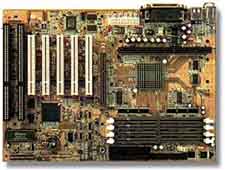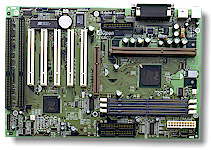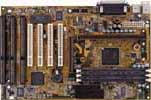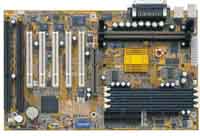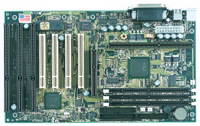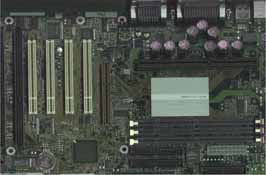
Original Link: https://www.anandtech.com/show/294
May 1999 Slot-1 BX Motherboard Roundup
by Anand Lal Shimpi on May 9, 1999 8:15 PM EST- Posted in
- Motherboards
The summer is almost upon us and the motherboard industry is slowly winding down to give us all the calm before the 4th quarter storm that will bring the next wave of motherboards to our computers. While a large portion of AnandTech readers have already put together their 300A/BH6 and 500/AX6BC combos, there are still a number of users out there that have yet to set foot in the current BX motherboard market. For them, there is still a world of options to choose from.
A full eight months after AnandTech's last Slot-1 BX motherboard comparison, it's time for another roundup to conclude the reign of the Slot-1 BX platform. AnandTech rounded up a total of 23 single processor Slot-1 BX motherboards that have been reviewed or in the process of being reviewed at AnandTech and managed to level the playing field and crown a couple of winners in the process.
Who came out on top? Let's just say that this time around, there are many more options than the ABIT BH6 which so effortlessly stole the crown from the competition back in September '98. It's time, but let's first start off by looking at what goes into every buying decision when you're considering a single processor Slot-1 BX motherboard.
The Basics: What to look for in a BX board
The basics of what to look for in a BX board haven't really changed all that much since the BX chipset was first released last year. However the basic requirements are still important enough to restate and explain for those of you that happen to be in the market for a new BX motherboard.
Form Factor & Size
There are two standard form factors and three distinct sizes that most mainstream BX motherboards are currently available in. Depending on the case you're looking to buy and the room that case happens to have, your final decision could be greatly influenced by the form factor and size of the motherboard you choose.
By far the most popular form factor Slot-1 BX motherboards are made available in is the ATX specification. If you're building a computer from scratch, it is strongly encouraged that you pursue an ATX configuration simply because it is the most popular and supported form factor standard available today. Unfortunately, one drawback of the ATX specification is that the specification calls for a much more advanced and thus more expensive case/power supply design. Former AT motherboard/case owners will find themselves laughing at the relatively miniscule ATX case $100 can buy in comparison to what $100 worth of an AT case translates in to.
For those of you that currently have larger AT cases and can't bring yourself to part with them, you are severely limiting your choices for a motherboard as there are very few AT form factor BX motherboards on the market today.
The three aforementioned sizes that most BX motherboards are available in applies to both ATX and AT BX boards, with a slight change in the nomenclature. You can represent the three different sizes just as easily as you can represent three different drink sizes, as small, medium, and large. The small being the microATX or baby AT boards, the medium being the standard ATX or standard AT boards, and finally, the large being the full ATX or full AT motherboards.
A large majority of today’s slot-1 BX motherboards are available in standard ATX flavors, however a few manufacturers have explored both the microATX and full ATX sizes as an attempt at getting the edge over the competition. A currently weak area in the motherboard industry is in the supply of AT form factor BX motherboards, with a very small percentage of manufacturers bothering to dedicate their time to producing newer AT boards.
The only reason you should pursue an AT BX board is if you have a great deal of money invested in a large AT case (or if you have a particular need for a larger AT case). Otherwise an investment in an AT BX board would be another way of quickly bringing about a curse of obsolescence.
Expansion Slots
Always a consideration, the expansion potential of your next motherboard should be sufficient to tend to your needs for at least the next year. Since your motherboard should be rarely upgraded when speaking in terms of individual upgrades to your system (usually a motherboard upgrade goes hand in hand with a CPU upgrade), you’ll want to make sure that your next motherboard is capable of supporting more than enough devices than you have installed. Although you may have a need for only 3 PCI slots now, a couple months down the road a new peripheral may be on your wish list, and you definitely don’t want to have to upgrade your motherboard just so you can take advantage of the latest TV tuner.
There are two major expansion slot configurations motherboard manufacturers have chosen to unofficially standardize known to AnandTech readers as the 5/2/1 and 4/3/1 expansion slot configurations. The configuration notation used by AnandTech represents the number of PCI/ISA/AGP slots on the motherboard. That notation will soon change in 1999, the why behind that change will be discussed a little later.
Another consideration when looking at expansion slots is whether or not the expansion slots are capable of accepting full-length cards. Older devices such as many 16-bit ISA sound cards happened to be unusually longer than most other cards, and thus required a larger clearance on a motherboard to be installed properly. While most PCI cards do not suffer from this same handicap, owners of 3dfx Voodoo2 cards (with the exception of the Canopus Pure3D-2, which is a full 1" shorter than other V2 cards) will also share the need for full length PCI slots.
The idea of having the full-length AGP slot emerged in 1998, however most full-length AGP cards are reserved for high-end workstations and are rarely seen in the desktop market. Needless to say, motherboard manufacturers have taken this suggestion into account, and many newer BX boards now accept full-length AGP cards.
Memory & Cacheable Area
In spite of the chipset's support for EDO DRAM, no BX boards have been made commercially available with SIMM slots, DIMMs are the current fad and expect them to stay that way until Intel’s next chipset, the i820 (codename Camino) catches on. You'll find boards with either 3 or 4 DIMM slots on them, and unless you plan on using more than 3 DIMMs there is no real advantage to going with a board that has 4 DIMM slots versus one that has 3 slots. There is no performance increase or decrease related to using many smaller DIMMs in comparison to one larger DIMM (i.e. 2 - 32MB vs 1 - 64MB). It is best to purchase one larger DIMM so you don't have to worry about running out of space for memory expansion just in case you feel the need to purchase more memory when the price drops. This suggestion is somewhat overly simplified due to the fact that in 1999, there are some new factors that one must take into account when purchasing DIMMs of larger sizes, a topic that will be discussed later on in this comparison.
Unlike the older Socket-7 motherboards you may be familiar with, Slot-1 Pentium II boards don't have a Cacheable Memory Limit set directly as a function of the motherboard. Instead, it is the processor's duty (courtesy of the on-card L2 cache of the Pentium II) to cache all DRAM. Older Pentium II's with 512KB of L2 cache can cache up to 512MB of RAM, while the newer Pentium II chips (350/400) can cache up to 4GB of system memory...try maxing that limit out with 4 DIMM slots.
The cacheable memory area on the original Celeron processors is, naturally, 0MB. Yes, you read right, that is zero megabytes, this is because the original Celeron's don't have any L2 cache, and if you don't have any L2 cache it is impossible to use the L2 cache to cache a certain range of system memory to speed up access to it. The newer Celeron processors, with 128KB of integrated L2 cache, allow for a cacheable memory area of 4GB of system memory like the newer Pentium II processors, so once again, you won't experience any problems caching the RAM you decide to stick into your new BX motherboard.
What to look for in a BX board in 1999
The times have changed, and looking for a BX board is no longer the same as it once was, there are now a number of other factors that must be taken into consideration when purchasing a new motherboard. While some factors have changed slightly, others have been completely renovated, the bottom line still exists, choosing a BX board based on the same logic from the previous years won’t get you anywhere.
Expansion Slots
The number of expansion slots on motherboards still hasn’t changed, with a total of 8 slots being present (7 usable). What has changed is the addition of another slot configuration intended to offer a third and more expansion-friendly option to the older 4/3/1 and somewhat newer 5/2/1 choices. The idea of having a motherboard with 6 PCI slots gave birth to the 6/1/1 expansion slot configuration, first introduced by Tyan in August of 1998. Since then, a few competing manufacturers have endorsed the 6/1/1 expansion slot configuration, including ASUS and TMC. You can expect the latter part of this year to bring about the introduction of quite a few motherboards with 6 PCI slots.
As briefly mentioned earlier, the PCI/ISA/AGP expansion slot nomenclature AnandTech has been using to identify motherboards is going to be replaced soon enough on AnandTech with the introduction of the first motherboards with the AMR slot. AMR stands for Audio-Modem Riser, allowing for motherboard manufacturers to integrate Audio/Modem Codecs onto the motherboard and allow for them to be taken advantage of by a low-cost AMR add-in card. No BX boards will feature AMR slots, however future boards based on Intel’s 810 and 820 chipsets, as well as boards based on VIA’s MVP4 solution will feature the new slot. In the future, when you read about a motherboard with a 6/1/1 configuration chances are that the last 1 will be referring to an AMR slot rather than an AGP slot.
Integrated Audio/Video
A once ridiculed feature, integrated audio and video has quickly gained popularity among advocates of the sub-$1000 PC. A consideration that must be made when looking at a board with either integrated audio or video (or both) is the manufacturer of the audio/video device(s) as well as their "card equivalent" or what add-in card they are essentially the same as. For example, most newer motherboards with on-board sound come equipped with the Creative Labs ES1373 PCI audio controller whose "card equivalent" is the Creative Labs Sound Blaster PCI64.
Another consideration to take into account is whether or not the integrated components are actually PCI or ISA peripherals. Although they don’t physically occupy a slot on the motherboard, an integrated audio controller can either be a PCI or an ISA device, and can therefore "occupy" what would normally be another PCI or ISA slot. As you would expect, a motherboard with integrated video could either be a PCI or an AGP device, in the latter case that motherboard would come equipped with no AGP slots at all due to the integrated AGP video. An example of a board with integrated AGP video would be the Intel SR440BX, whose integrated AGP NVIDIA Riva TNT graphics accelerator takes the place of the AGP slot that would normally be present on the motherboard.
Memory Buffers: The Hype
ABIT’s introduction of the original BX6, one of the first BX boards to hit the market, boasted a handful of new and "revolutionary" features that went unmatched by any competing motherboard manufacturers. Among the features was the inclusion of a 6-chip external DRAM buffer, which was designed to help improve stability when using all 4 DIMM slots. ABIT never officially stated that the buffer would in fact increase stability, nor did they ever confirm that the DRAM buffer was necessary, they just included the buffer and dubbed it a "feature" on the BX6.
Now, a little under a year after the BX6’s introduction, the truth happens to be that the 6-chip external DRAM buffer does absolutely nothing for the stability of the board when using all 4 DIMM slots. The idea behind the buffer is simple, when the power drawn by the memory banks increases, the power fed to them as well as the clarity of the electrical signals feeding them must remain as clear as the signal present when only one DIMM is installed. As you increase the amount of resistance an electrical signal must fight in order to reach the other end of a circuit (in this case traveling to/from the 443BX North Bridge controller from/to the memory banks) there are issues of capacitance that must be taken into account. While some manufacturers have insisted that a DRAM buffer isn’t necessary to help maintain signal strength and clarity, by saying that a reduction in the trace length between the DRAM banks and the 443BX controller is all that is necessary (the distance between the main chip of the BX chipset and the memory banks) there are others, such as ABIT, that claim the 6-chip DRAM buffer is a necessity to prevent any capacitance related issues with the motherboard’s stability.
There is some truth to this, basically as a motherboard manufacturer you want to have the memory banks as close to the memory controller (443BX chip in this case) as physically possible to keep the length of individual traces between the two down to a minimum, however the addition of the DRAM buffer doesn’t necessarily remove the need for that.
In AnandTech’s own internal testing, the ABIT BX6 and the newer BX6 Revision 2.0 performed considerably worse (in terms of stability) with 4 – 128MB DIMMs of the same type than other motherboards that lacked the DRAM buffer. Although your mileage may vary depending on the type of DIMMs used, something to keep in mind when purchasing a BX motherboard is that maxing out all of your memory banks isn’t encouraged unless you happen to have a high-end server board or a board with a proven stability track record. DRAM buffer or not, ABIT’s BX6 isn’t a board you want running in a server where every crash counts against you.
256MB DIMMs: The Problem
With the growing need for larger memory configurations, many memory manufacturers are turning to slightly unorthodox yet popular ways of releasing 256MB and larger DIMMs. The problem memory manufacturers have is this, on your standard 64MB SDRAM DIMM you have a total of 8 chips (non-ECC). Basic math will tell you that 8 chips x 8MB per chip gives you a total of 64MB, the total size of the memory module. Since these 8 chips only occupy one side of the double sided module, the second side can be populated with another 8 chips to make a total of 128MB (8 chips x 8MB per chip x 2 sides). The problem comes in when you want something larger than 128MB, there are no 3rd and 4th sides to include 8 more chips on for a 256MB module.
So what do you do? The skyscraper method, build upwards. Hitting 256MB requires that you essentially stack another 128MB module upon an existing 128MB module, mainly because 16MB and 32MB SDRAM chips are not plentiful (nor cheap) enough for manufacturers to start releasing double sided 256MB SDRAM DIMMs made up of 16 chips of 16MB a piece. In turn, this causes a severe problem with motherboards, since the profit margin on a single motherboard is quite low, every corner must be cut and every dollar must be saved during the manufacturing process. When you combine a 256MB SDRAM DIMM (essentially made up of 2 - 128MB DIMMs) with a motherboard that wasn’t tested with that particular module, you get a major problem. In most cases, your system will be extremely unstable or will simply fail to boot, giving you a memory error beep code.
The problem is even worse with 512MB DIMMs. The solution? Unfortunately, the solution is to either buy smaller memory DIMM modules or a motherboard that can handle the particular DIMMs you are looking to use. Companies like Tyan, that manufacture motherboards intended for use in high-end configurations, have put together recommended SDRAM lists based on modules that have been known to work properly with their motherboards. Your best bet in that case would be to consult your motherboard manufacturer before popping in a few hundred bucks worth of SDRAM in your system that may or may not work. From personal experience, one of the most frustrating things is when your $3000 512MB SDRAM module won’t work in your server motherboard, and there isn’t a 256MB memory vendor around on a Sunday night. The things that go on behind the scenes at AnandTech ;)
BIOS Setup & System Monitoring
The BIOS setup of a motherboard is an often overlooked feature, however it is a very important one that must be taken into account. The BIOS setup, whether made by Award, AMI, or Phoenix, contains a few key options that can determine whether or not your experience will be a pleasant one, especially down the road when you start adding in more peripherals.
The ability to individually assign IRQs to PCI slots is a priceless feature that many motherboard manufacturers refrain from supporting, simply because it?s a feature that quite a few users overlook. The ability to assign IRQs to individual PCI slots can be a tremendous aid in solving IRQ conflicts where your "wonderful" OS doesn?t seem to be of much help. A new feature you'll want to look into is the ability to enable/disable Intel's new Processor Identification number, however this feature should quickly appear in virtually all BIOS setup utilities as it is nothing more than a BIOS modification
The ability to enable/disable IRQs for devices such as the PS/2 mouse port, PCI VGA adapters, USB adapters, and any on-board peripherals seems like a feature that should naturally be included in any BIOS setup, unfortunately that is not always the case. While most newer motherboards come with up-to-date BIOSes that do allow for this sort of configuration, the cheaper boards out there don?t always offer the same. Did someone say you get what you pay for?
Jumperless Setups & Voltage Manipulation
For a single processor BX board, there is no excuse for a manufacturer not to include a jumperless CPU setup. Although the number of jumperless motherboards has increased dramatically in the past few months, the total is still quite low. Inspired by a thriving success on ABIT?s part, most motherboard manufacturers are pursuing jumperless or pseudo-jumperless designs to make their boards even easier to use. While a jumperless design is preferred, it?s not required, the big question is why haven?t more motherboard manufacturers pursued a manual CPU voltage adjustment utility ala-ABIT.
Currently there are only two motherboards that allow for the adjustment of the core voltage of the Pentium II/III/Celeron CPUs, ABIT?s BX6/BH6/BX6 Revision 2, and the new Microstar MSI 6163. Although there have been rumors that AOpen?s newest revision of the AX6BC does allow for manual voltage configuration, these AX6BC boards don?t seem to be readily available to the masses just yet, so you may want to hold off on that decision for now. The MSI 6163 has been sitting in AnandTech?s labs for quite a while now, unfortunately the sample doesn?t seem to be stable enough to complete a full run through Winstone, and therefore the board cannot be evaluated. AnandTech will be working with MSI in the future to find out the cause of the stability problems (hopefully they are just isolated to this sample) and attempt to resolve them, at which point this comparison will be updated.
Other Features & Support
Features such as the SB-Link, originally intended to help maintain DOS legacy compatibility by newer PCI Sound Blaster cards, are not really that important and usually won’t be a reason to sway your decision one way or the other with a motherboard. Some more useful features include BIOS level Anti-Virus protection, however that is still no true replacement for Anti-Virus software, a reason that some manufacturers have started to bundle Anti-Virus programs with their motherboards, there’s some bang for your buck.
One of the most important features when dealing with any motherboard is the support the backs it. Support is available not only in the form of written documentation but through the manufacturers’ web site in the form of driver downloads, BIOS updates, and more. It’s always good practice to check around motherboard manufacturers’ web sites in order to see the frequency at which they update their BIOSes (especially for older motherboards). There is no replacement for word of mouth passed on by other users, it seems like motherboards don’t inspire the same tension that video cards and CPUs do when it comes to asking for advice. Whereas asking the question "3dfx or NVIDIA?" or "AMD or Intel" in most newsgroups will end up in a flame war, asking for personal experiences with a particular motherboard manufacturer on-line will usually give you a good set of responses to help gauge your motherboard manufacturer’s support rating. The AnandTech Motherboard Discussion Forum on the AnandTech BBS is an excellent place to ask about individual experiences with motherboard manufacturers.
Performance Still not an Issue
Towards the end of the reign of the Intel LX chipset we started to notice a decreasing performance gap among motherboards, and in AnandTech’s first BX motherboard comparison the slowest of the pack (Tyan Tsunami) was separated from the fastest of the bunch (ABIT BX6) under Winstone 98 by an insignificant 1.3 points.
There’s one thing that’s for sure, performance is no longer a deciding factor, and in most cases not even an influential factor when dealing with a BX motherboard purchase.
Quick Comparison
Chart |
||||||||
| Motherboard | Expansion Config | Memory Slots | Form Factor | Jumperless | Voltage Adj. | Sound | SCSI | Video |
| ABIT BH6 | 5/2/1 | 3 | std. ATX | Y | Y | N | N | N |
| ABIT BX6 | 4/3/1 | 4 | full ATX | Y | Y | N | N | N |
| ABIT BX6 Revision 2 | 5/2/1 | 4 | full. ATX | Y | Y | N | N | N |
| AOpen AX6B | 4/3/1 | 4 | full ATX | Y | N | N | N | N |
| AOpen AX6BC | 5/2/1 | 3 | std. ATX | Y | N | N | N | N |
| ASUS P2B | 4/3/1 | 3 | std. ATX | N | N | N | N | N |
| Chaintech 6BTM | 4/3/1 | 4 | full ATX | Y | N | N | N | N |
| DFI P2XBL | 4/3/1 | 3 | std. ATX | N | N | N | N | N |
| Diamond C400 | 5/2/1 | 3 | std. ATX | Y | N | N | N | N |
| Elitegroup P6BXT-A+ | 4/2/1 | 3 | std. ATX | Y | N | Y | N | N |
| FIC VB-601 | 5/2/1 | 4 | std. ATX | N | N | N | N | N |
| Gigabyte BX2000 | 5/2/1 | 4 | std. ATX | N | N | N | N | N |
| Intel SE440BX | 4/2/1 | 3 | std. ATX | Y | N | N | N | N |
| Intel SR440BX | 4/1/0 | 2 | micro ATX | Y | N | Y | N | Y |
| Shuttle HOT-641P | 4/3/1 | 4 | full ATX | N | N | N | N | N |
| Shuttle HOT-661P | 4/3/1 | 4 | std. ATX | Y | N | N | N | N |
| Shuttle HOT-663 | 4/3/1 | 4 | std. ATX | Y | N | N | N | N |
| Shuttle HOT-675 | 5/2/1 | 3 | std. ATX | Y | N | N | N | N |
| Shuttle HOT-679 | 3/1/0 | 3 | micro ATX | Y | N | Y | N | Y |
| Soyo SY-6BA | 5/2/1 | 4 | full ATX | Y | N | N | N | N |
| Supermicro P6SBA | 4/3/1 | 3 | std. ATX | N | N | N | N | N |
| TMC TI6NB | 5/2/1 | 4 | std. ATX | Y | N | N | N | N |
| Tyan S1830S Tsunami AT | 4/4/1 | 4 | full AT | N | N | N | N | N |
| Tyan S1846 Tsunami ATX | 5/2/1 | 3 | full ATX | N | N | N | N | N |
Best Overall Single Processor BX Motherboard
| 1st Runner Up: Best Overall Single Processor BX Motherboard | ||
|
ABIT's name stands strong behind their newest flagship, the BX6 Revision 2. The second revision of their original knockout BX board comes with all of the thrills a BX board owner could possibly ask for, as well as the well known SoftMenuTM Jumperless CPU setup and the ability to manually adjust the core voltage of your processor. |
ABIT BX6 Revision 2 |
| Lacking only in stability and punished by its larger size, the BX6 Revision 2 does end up with a fairly honorable mention as the 2nd runner up in this category. | ||
| Best Overall Single Processor BX Motherboard | ||
|
The AOpen AX6BC's combination of stability and reliability make up one of the three pillars upon which AOpen has stood on in the industry. | AOpen AX6BC |
| The AX6BC offers solid performance, a standard expansion slot configuration, strong support from the manufacturer, and is a readily available board in the market. The board's major downsides include the lack of a voltage configuration utility (a change that seems to be present in some very rare versions of the AX6BC) and the unfortunate positioning of the floppy connector on the board. Other than that, the AX6BC is ideal for overclockers, normal and even high-end users not looking for on-board SCSI or multi-processor support. | ||
Best Single Processor BX Motherboard for Overclockers
| 2nd Runner Up: Best Single Processor BX Motherboard for Overclockers | ||
|
Solid, stable operation, generally positive user feedback, and the ASUS name bring the P2B a close 3rd place. The limiting factors for the P2B include the age-old 4/3/1 expansion slot configuration (corrected in the P2B-F), and the lack of a voltage configuration utility. | ASUS P2B |
| 1st Runner Up: Best Single Processor BX Motherboard for Overclockers | ||
|
Albeit more stable than the BX6 Revision 2, the lack of a voltage adjustment feature leaves the AX6BC with the 2nd runner up award in this category. If the newer models of the AX6BC do begin shipping with the elusive voltage adjustment setting things could change in this category... | AOpen AX6BC |
| Best Single Processor BX Motherboard for Overclockers | ||
|
Could this award go to any other company? The BX6 Revision 2 is the absolute best motherboard for overclockers. Supporting a wide variety of FSB frequencies and sporting the ability to adjust the CPU core voltage of any installed processor, the BX6 Rev2 is the hands-down winner in this category. | ABIT BX6 Revision 2 |
Most Stable Single Processor BX Motherboard
| 2nd Runner Up: Most Stable Single Processor BX Motherboard | ||
|
AnandTech's first tests on a Gigabyte manufactured motherboard went extremely well, as the BX2000 came away with very high stability marks, virtually tying with the second runner up, the AOpen AX6BC, both of which are excellent motherboards in more than one respect. | AOpen AX6BC Gigabyte BX2000 |
| 1st Runner Up: Most Stable Single Processor BX Motherboard | ||
|
Taking from its older, dual-processor brothers, the Supermicro P6SBA brings the server-tradition down to an affordable, single-processor level. While the air seems to have rushed out of Tyan's single processor motherboards in terms of quality, Supermicro has kept the high-end tradition alive with the P6SBA. | Supermicro P6SBA |
| Most Stable Single Processor BX Motherboard | ||
|
Intel may not make the best motherboards, their expansion capabilities may be some of the worst you've seen, and their potential for overclocking may be non-existent, but when the CPU giant sits down to make a motherboard, they make sure that board does one thing: run like it should. Chances are that you won't want a SE440BX, but don't turn one away for a solid second system, as it'll take quite a bit before it even hiccups. | Intel SE440BX |


